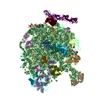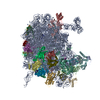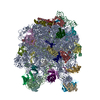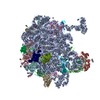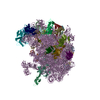[English] 日本語
 Yorodumi
Yorodumi- EMDB-5643: Cryo-EM structures of the late-stage assembly intermediates of 50... -
+ Open data
Open data
- Basic information
Basic information
| Entry | Database: EMDB / ID: EMD-5643 | |||||||||
|---|---|---|---|---|---|---|---|---|---|---|
| Title | Cryo-EM structures of the late-stage assembly intermediates of 50S ribosome subunit from YlqF-deficient Bacillus subtilis strain. | |||||||||
 Map data Map data | 3D classification of the assembly intermediates of 50S ribosome subunit from YlqF-deficient Bacillus subtilis strain | |||||||||
 Sample Sample |
| |||||||||
 Keywords Keywords |  Ribosome biogenesis / ribosome assembly intermediate / RNA folding Ribosome biogenesis / ribosome assembly intermediate / RNA folding | |||||||||
| Function / homology |  Function and homology information Function and homology informationpositive regulation of rRNA processing /  nucleoid / rRNA processing / large ribosomal subunit rRNA binding / large ribosomal subunit / nucleoid / rRNA processing / large ribosomal subunit rRNA binding / large ribosomal subunit /  regulation of translation / cytoplasmic translation / cytosolic large ribosomal subunit / regulation of translation / cytoplasmic translation / cytosolic large ribosomal subunit /  transferase activity / negative regulation of translation ...positive regulation of rRNA processing / transferase activity / negative regulation of translation ...positive regulation of rRNA processing /  nucleoid / rRNA processing / large ribosomal subunit rRNA binding / large ribosomal subunit / nucleoid / rRNA processing / large ribosomal subunit rRNA binding / large ribosomal subunit /  regulation of translation / cytoplasmic translation / cytosolic large ribosomal subunit / regulation of translation / cytoplasmic translation / cytosolic large ribosomal subunit /  transferase activity / negative regulation of translation / transferase activity / negative regulation of translation /  tRNA binding / tRNA binding /  rRNA binding / rRNA binding /  ribosome / structural constituent of ribosome / ribosome / structural constituent of ribosome /  translation / translation /  ribonucleoprotein complex / response to antibiotic / ribonucleoprotein complex / response to antibiotic /  mRNA binding / mRNA binding /  DNA binding / DNA binding /  RNA binding / RNA binding /  cytoplasm cytoplasmSimilarity search - Function | |||||||||
| Biological species |   Bacillus subtilis (bacteria) Bacillus subtilis (bacteria) | |||||||||
| Method |  single particle reconstruction / single particle reconstruction /  cryo EM / Resolution: 10.7 Å cryo EM / Resolution: 10.7 Å | |||||||||
 Authors Authors | Li N / Chen Y / Guo Q / Zhang Y / Yuan Y / Ma C / Deng H / Lei J / Gao N | |||||||||
 Citation Citation |  Journal: Nucleic Acids Res / Year: 2013 Journal: Nucleic Acids Res / Year: 2013Title: Cryo-EM structures of the late-stage assembly intermediates of the bacterial 50S ribosomal subunit. Authors: Ningning Li / Yuling Chen / Qiang Guo / Yixiao Zhang / Yi Yuan / Chengying Ma / Haiteng Deng / Jianlin Lei / Ning Gao /  Abstract: Ribosome assembly is a process fundamental for all cellular activities. The efficiency and accuracy of the subunit assembly are tightly regulated and closely monitored. In the present work, we ...Ribosome assembly is a process fundamental for all cellular activities. The efficiency and accuracy of the subunit assembly are tightly regulated and closely monitored. In the present work, we characterized, both compositionally and structurally, a set of in vivo 50S subunit precursors (45S), isolated from a mutant bacterial strain. Our qualitative mass spectrometry data indicate that L28, L16, L33, L36 and L35 are dramatically underrepresented in the 45S particles. This protein spectrum shows interesting similarity to many qualitatively analyzed 50S precursors from different genetic background, indicating the presence of global rate-limiting steps in the late-stage assembly of 50S subunit. Our structural data reveal two major intermediate states for the 45S particles. Consistently, both states severally lack those proteins, but they also differ in the stability of the functional centers of the 50S subunit, demonstrating that they are translationally inactive. Detailed analysis indicates that the orientation of H38 accounts for the global conformational differences in these intermediate structures, and suggests that the reorientation of H38 to its native position is rate-limiting during the late-stage assembly. Especially, H38 plays an essential role in stabilizing the central protuberance, through the interaction with the 5S rRNA, and the correctly orientated H38 is likely a prerequisite for further maturation of the 50S subunit. | |||||||||
| History |
|
- Structure visualization
Structure visualization
| Movie |
 Movie viewer Movie viewer |
|---|---|
| Structure viewer | EM map:  SurfView SurfView Molmil Molmil Jmol/JSmol Jmol/JSmol |
| Supplemental images |
- Downloads & links
Downloads & links
-EMDB archive
| Map data |  emd_5643.map.gz emd_5643.map.gz | 54.2 MB |  EMDB map data format EMDB map data format | |
|---|---|---|---|---|
| Header (meta data) |  emd-5643-v30.xml emd-5643-v30.xml emd-5643.xml emd-5643.xml | 11.7 KB 11.7 KB | Display Display |  EMDB header EMDB header |
| Images |  emd_5643_1.jpg emd_5643_1.jpg emd_5643_2.tif emd_5643_2.tif | 71.7 KB 533.9 KB | ||
| Archive directory |  http://ftp.pdbj.org/pub/emdb/structures/EMD-5643 http://ftp.pdbj.org/pub/emdb/structures/EMD-5643 ftp://ftp.pdbj.org/pub/emdb/structures/EMD-5643 ftp://ftp.pdbj.org/pub/emdb/structures/EMD-5643 | HTTPS FTP |
-Related structure data
| Related structure data |  3j3wMC  5642C  3j3vC M: atomic model generated by this map C: citing same article ( |
|---|---|
| Similar structure data |
- Links
Links
| EMDB pages |  EMDB (EBI/PDBe) / EMDB (EBI/PDBe) /  EMDataResource EMDataResource |
|---|---|
| Related items in Molecule of the Month |
- Map
Map
| File |  Download / File: emd_5643.map.gz / Format: CCP4 / Size: 62.5 MB / Type: IMAGE STORED AS FLOATING POINT NUMBER (4 BYTES) Download / File: emd_5643.map.gz / Format: CCP4 / Size: 62.5 MB / Type: IMAGE STORED AS FLOATING POINT NUMBER (4 BYTES) | ||||||||||||||||||||||||||||||||||||||||||||||||||||||||||||||||||||
|---|---|---|---|---|---|---|---|---|---|---|---|---|---|---|---|---|---|---|---|---|---|---|---|---|---|---|---|---|---|---|---|---|---|---|---|---|---|---|---|---|---|---|---|---|---|---|---|---|---|---|---|---|---|---|---|---|---|---|---|---|---|---|---|---|---|---|---|---|---|
| Annotation | 3D classification of the assembly intermediates of 50S ribosome subunit from YlqF-deficient Bacillus subtilis strain | ||||||||||||||||||||||||||||||||||||||||||||||||||||||||||||||||||||
| Voxel size | X=Y=Z: 1.5 Å | ||||||||||||||||||||||||||||||||||||||||||||||||||||||||||||||||||||
| Density |
| ||||||||||||||||||||||||||||||||||||||||||||||||||||||||||||||||||||
| Symmetry | Space group: 1 | ||||||||||||||||||||||||||||||||||||||||||||||||||||||||||||||||||||
| Details | EMDB XML:
CCP4 map header:
| ||||||||||||||||||||||||||||||||||||||||||||||||||||||||||||||||||||
-Supplemental data
- Sample components
Sample components
-Entire : Assembly intermediate of 50S ribosome subunit from YlqF-deficient...
| Entire | Name: Assembly intermediate of 50S ribosome subunit from YlqF-deficient Bacillus subtilis strain |
|---|---|
| Components |
|
-Supramolecule #1000: Assembly intermediate of 50S ribosome subunit from YlqF-deficient...
| Supramolecule | Name: Assembly intermediate of 50S ribosome subunit from YlqF-deficient Bacillus subtilis strain type: sample / ID: 1000 / Number unique components: 1 |
|---|
-Supramolecule #1: assembly intermediate of 50S ribosome subunit from YlqF-deficient...
| Supramolecule | Name: assembly intermediate of 50S ribosome subunit from YlqF-deficient Bacillus subtilis strain type: complex / ID: 1 / Name.synonym: immature 50S ribosome / Recombinant expression: No / Database: NCBI / Ribosome-details: ribosome-prokaryote: LSU 50S |
|---|---|
| Source (natural) | Organism:   Bacillus subtilis (bacteria) / Strain: Bacillus subtilis subsp. subtilis str. 168 Bacillus subtilis (bacteria) / Strain: Bacillus subtilis subsp. subtilis str. 168 |
-Experimental details
-Structure determination
| Method |  cryo EM cryo EM |
|---|---|
 Processing Processing |  single particle reconstruction single particle reconstruction |
| Aggregation state | particle |
- Sample preparation
Sample preparation
| Buffer | pH: 7.5 / Details: 100mM NH4Cl, 20mM Tris-HCl, 10mM MgOAc2, 1mM TCEP |
|---|---|
| Vitrification | Cryogen name: ETHANE / Chamber humidity: 100 % / Instrument: FEI VITROBOT MARK IV / Method: Blot for 20 seconds before plunging |
- Electron microscopy
Electron microscopy
| Microscope | FEI TITAN KRIOS |
|---|---|
| Electron beam | Acceleration voltage: 300 kV / Electron source:  FIELD EMISSION GUN FIELD EMISSION GUN |
| Electron optics | Illumination mode: FLOOD BEAM / Imaging mode: BRIGHT FIELD Bright-field microscopy / Cs: 2.7 mm / Nominal defocus max: 4.0 µm / Nominal defocus min: 1.0 µm / Nominal magnification: 59000 Bright-field microscopy / Cs: 2.7 mm / Nominal defocus max: 4.0 µm / Nominal defocus min: 1.0 µm / Nominal magnification: 59000 |
| Sample stage | Specimen holder model: FEI TITAN KRIOS AUTOGRID HOLDER |
| Date | Dec 6, 2011 |
| Image recording | Category: CCD / Film or detector model: FEI EAGLE (4k x 4k) / Average electron dose: 20 e/Å2 |
| Experimental equipment |  Model: Titan Krios / Image courtesy: FEI Company |
- Image processing
Image processing
| CTF correction | Details: Each particle |
|---|---|
| Final reconstruction | Algorithm: OTHER / Resolution.type: BY AUTHOR / Resolution: 10.7 Å / Resolution method: OTHER / Software - Name: RELION / Number images used: 27652 |
| Details | This is one of the classified groups with the software RELION |
-Atomic model buiding 1
| Initial model | PDB ID:  2aw4 |
|---|---|
| Software | Name: S2S, modeRNA, MODELLER, MDFF |
| Details | Atom models of the 23S and 5S rRNAs were built using the software S2S and modeRNA, with the crystal structures of the 50S subunits from E. coli (PDB ID: 2AW4) and Thermus thermophilus (PDB ID: 2J01) as template. Models of ribosomal proteins, L1, L3, L4, L6, L10, L13, L14, L15, L17, L19, L20, L21, L22, L23, L24, L27, L29, L30, L31, L32, L33, L34, L35 and L36 were downloaded from the SWISS-MODEL Repository. The others, including L2, L5, L11, L16, L18 and L28 were modeled using MODELLER with crystal structures of E. coli and T. thermophilus 50S subunits as templates.The combined atomic model of the B. subtilis 50S subunit was docked into a high resolution mature 50S density map and optimized using MDFF. This optimized model was docked into the EM density using Chimera and flexible fitted into the density using MDFF |
| Refinement | Space: REAL / Protocol: FLEXIBLE FIT / Target criteria: Cross-correlation coefficient |
| Output model |  PDB-3j3w: |
-Atomic model buiding 2
| Initial model | PDB ID:  2j01 |
|---|---|
| Software | Name: S2S, modeRNA, MODELLER, MDFF |
| Details | Atom models of the 23S and 5S rRNAs were built using the software S2S and modeRNA, with the crystal structures of the 50S subunits from E. coli (PDB ID: 2AW4) and Thermus thermophilus (PDB ID: 2J01) as template. Models of ribosomal proteins, L1, L3, L4, L6, L10, L13, L14, L15, L17, L19, L20, L21, L22, L23, L24, L27, L29, L30, L31, L32, L33, L34, L35 and L36 were downloaded from the SWISS-MODEL Repository. The others, including L2, L5, L11, L16, L18 and L28 were modeled using MODELLER with crystal structures of E. coli and T. thermophilus 50S subunits as templates.The combined atomic model of the B. subtilis 50S subunit was docked into a high resolution mature 50S density map and optimized using MDFF. This optimized model was docked into the EM density using Chimera and flexible fitted into the density using MDFF |
| Refinement | Space: REAL / Target criteria: Cross-correlation coefficient |
| Output model |  PDB-3j3w: |
 Movie
Movie Controller
Controller




